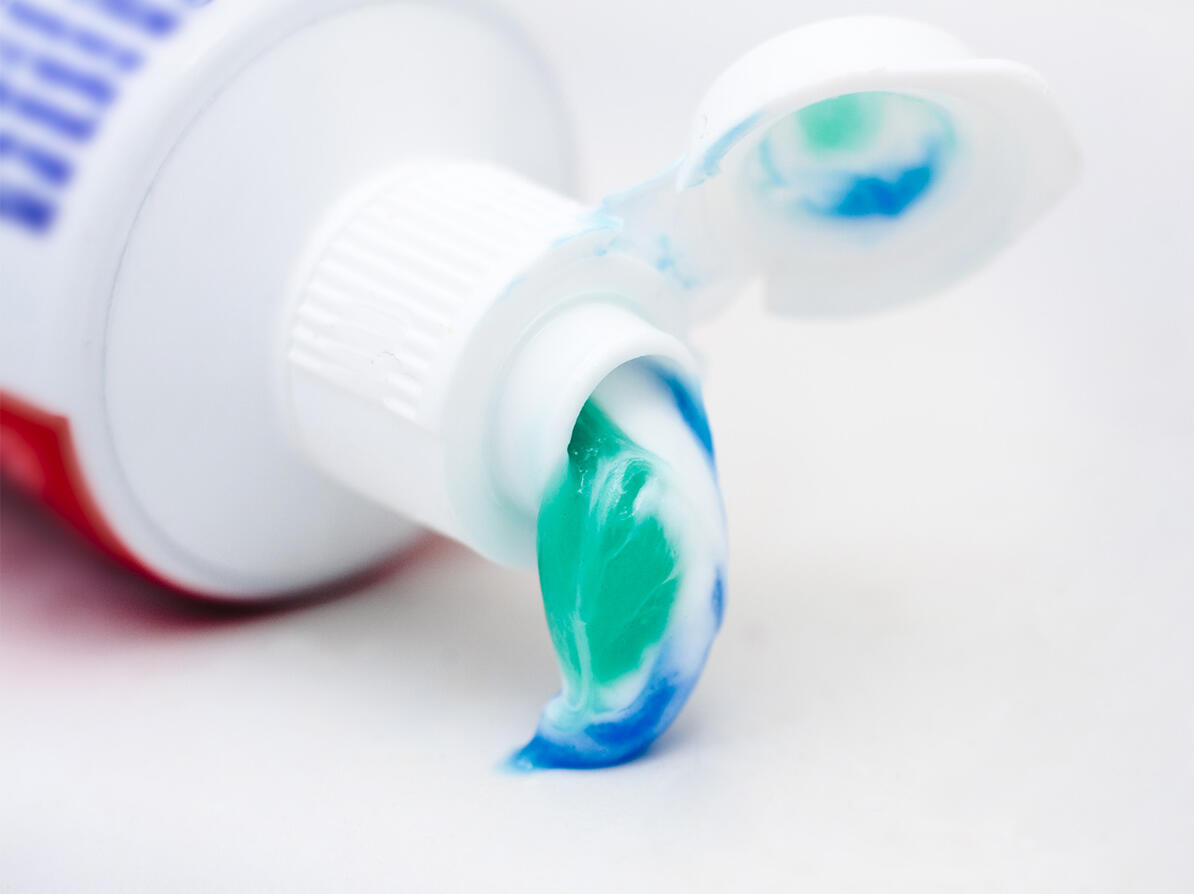Avoid these substances in toothpaste
Your toothpaste may contain substances suspected of damaging genetic material or being endocrine disruptors. See which substances to avoid.

We all use toothpaste, and dentists recommend fluoride toothpaste for the best protection against cavities.
The Danish Consumer Council THINK Chemicals has tested fluoride toothpaste for the presence of chemicals unwanted for your health and the environment.
These brands are included in the test
We have tested 31 toothpastes from Danish stores and online shops. We have selected toothpaste from both popular brands and niche brands.
The brands in the test are Avivir, Aquafresh, Best@care, Colgate, Clinomyn, Curaprox, Denivit, Denttabs, Dentalux, Dr. Jones, G.U.M, Green People, Jordan, Lavera, Kingfisher, Marvis, Oral-B, Parodontax, Parodol, Pierrot, Rema1000, SB12, Sence, Sensodyne, The Humble Co., Urtekram, Xtra, Zendium, Waken, and Änglamark.
Titanium dioxide in toothpaste
In the test, we found the colorant titanium dioxide in 11 toothpastes, which therefore receive a medium chemical rating, the B-rating. Compared to last year's test of toothpaste, it would appear that titanium dioxide is being phased out in toothpaste.
Titanium dioxide is a naturally occurring colour pigment that can make products like toothpaste appear chalk white.
Titanium dioxide can accumulate in the body and is suspected of damaging genetic material when ingested.
Therefore, the substance is prohibited as an additive in food, but it is still allowed in personal care products, which you inevitably ingest a part of during use.
We recommend keeping an eye out for titanium dioxide or CI 77891 in personal care products that you can ingest, such as toothpaste.
Avoid suspected endocrine-disrupting substances in toothpaste
In the test, 5 toothpastes receive the lowest chemical rating, C-rating.
They all contain substances suspected of being endocrine disruptors, such as parabens, triclosan, and methyl salicylate.
Endocrine-disrupting substances can, for example, affect the ability to conceive or contribute to certain forms of cancer.
Triclosan has long been under scrutiny. In addition to potentially affecting the hormonal system, the substance accumulates in the environment and can create resistant bacteria. The Environmental Protection Agency recommends completely avoiding triclosan.
These toothpastes perform poorly
In the test, these five toothpastes receive the lowest chemical rating because they contain suspected endocrine-disrupting substances:
- Denivit Anti-Stain Intense Toothpaste
- G.U.M. Paroex toothpaste
- Parodol Fluor toothpaste
- Pierrot Ultrafresh dental gel
- Sence Coolmint toothpaste
Fluoride in toothpaste is not the same as PFAS
Fluoride in toothpaste is sometimes confused with harmful fluorinated substances, also called PFAS. But they are not the same.
Fluorinated substances are used, among other things, to make outdoor clothing, frying pans, or dental floss water-, dirt-, and grease-repellent.
Fluoride in toothpaste is not the same type of substance. Fluoride in toothpaste is called inorganic fluoride and prevents cavities by strengthening tooth enamel.
Fluoride does not have the same properties as PFAS. However, small children should not ingest too much fluoride. Therefore, use only a small amount of toothpaste and teach them to spit it out.
Good advice on fluoride in toothpaste
The total exposure to unwanted chemicals in products can be problematic - not the individual product
It is generally a good idea to limit your exposure to endocrine-disrupting substances where you can. That way, you keep your total exposure as low as possible.
The individual toothpaste will not pose any health risk, even if it contains substances suspected of being endocrine disruptors.
But your - or your child's - total exposure to these substances may contribute to endocrine-disrupting effects. This is known as the cocktail effect.
About the test
-
We have purchased a large selection of toothpastes with fluoride from the Danish market. They were purchased in stores and online.
We have reviewed the ingredient lists for the presence of chemicals that may be allergenic, environmentally harmful, or endocrine disrupting.
-
Out of 31 toothpastes:
- 10 toothpastes are without unwanted chemicals.
- 16 toothpastes contain environmentally harmful substances or the colorant titanium dioxide (CI 77891).
- 5 toothpastes contain suspected endocrine-disrupting substances.
Titanium dioxide
Recent scientific research shows that titanium dioxide can accumulate in the body and may possibly damage genetic material when ingested. Titanium dioxide is also suspected of being carcinogenic if inhaled.
Therefore, titanium dioxide is prohibited as an additive in food, but it is still allowed in personal care products, which can also be ingested or inhaled.
We rate titanium dioxide in toothpaste with a medium chemical rating, the B-rating, because you may end up ingesting a part of the toothpaste during use.
In the test, titanium dioxide was found in 11 toothpastes. Several toothpaste manufacturers have announced that they are phasing out the substance and will soon launch new products.
Triclosan
Triclosan is an antibacterial substance that is suspected of being an endocrine disruptor. The substance can accumulate in the body and is suspected of developing resistance in bacteria. The substance was found in 1 toothpaste.
Parabens
Parabens in the form of methylparaben and sodium methylparaben are suspected of being endocrine disruptors. Parabens were found in 4 toothpastes in the test.
Environmentally harmful substances
In the test, we found zinc chloride, triclosan, thymol, and limonene, all of which can be problematic for the environment.